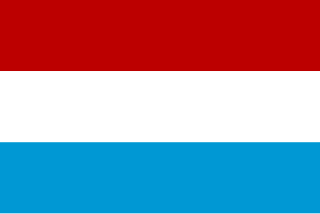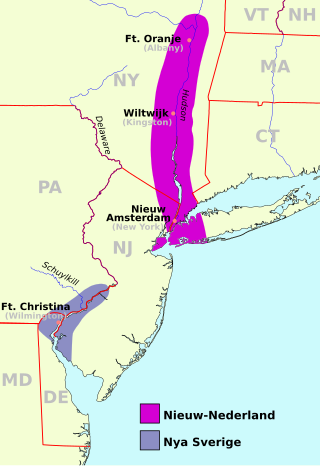
The Treaty of Hartford is a treaty concluded between New Netherland and Connecticut on September 19, 1650, in Hartford, Connecticut.

The Treaty of Hartford is a treaty concluded between New Netherland and Connecticut on September 19, 1650, in Hartford, Connecticut.
In 1650, Dutch Director-General of New Netherland Petrus Stuyvesant went to Hartford to negotiate a border with the governor of English Connecticut colony Edward Hopkins. The Dutch colony of New Netherland was feeling increased pressure from the rising number of English colonists at its borders.
Stuyvesant traded Connecticut land claims (the New Netherland claim encompassed the full length of the Connecticut River and as far east as Narragansett Bay) in order to get a clear boundary on Long Island. They agreed on a Connecticut line 50 Dutch miles west of the mouth of the Connecticut River. On Long Island, a line would be drawn south from the westernmost point of Oyster Bay, through modern Nassau County. The treaty was signed on September 19.
In practice, the treaty simply reflected changed facts on the ground. Settlement of the Dutch colony had clustered around the Hudson River with only isolated trading posts on the Connecticut (including Fort Hoop, which would become Hartford, Connecticut). The exploding population of New England, and the splintering impulses of its religious-based colonies, had led to significant English settlement in the Connecticut River Valley, along the coast of Long Island Sound and on eastern Long Island.
Back in Europe, the Dutch West India Company approved the treaty, but the English government, which rejected all Dutch claims in North America as illegitimate, did not. In America, however, the agreement held straight through the English conquest of New Netherland in 1664. Indeed, the borders today between Connecticut and New York, and between Nassau and Suffolk Counties on Long Island, are, with some minor adjustments, those negotiated in 1650.

New Amsterdam was a 17th-century Dutch settlement established at the southern tip of Manhattan Island that served as the seat of the colonial government in New Netherland. The initial trading factory gave rise to the settlement around Fort Amsterdam. The fort was situated on the strategic southern tip of the island of Manhattan and was meant to defend the fur trade operations of the Dutch West India Company in the North River. In 1624, it became a provincial extension of the Dutch Republic and was designated as the capital of the province in 1625.

Peter Stuyvesant was a Dutch colonial officer who served as the last Dutch director-general of the colony of New Netherland from 1647 until it was ceded provisionally to the English in 1664, after which it was split into New York and New Jersey with lesser territory becoming parts of other colonies, and later, states. He was a major figure in the early history of New York City and his name has been given to various landmarks and points of interest throughout the city.

New Netherland was a 17th-century colonial province of the Dutch Republic located on the east coast of what is now the United States. The claimed territories extended from the Delmarva Peninsula to southwestern Cape Cod, while limited settlements were in parts of the U.S. states of New York, New Jersey, Delaware, and Connecticut, with small outposts in Pennsylvania and Rhode Island.

The Netherlands began its colonization of the Americas with the establishment of trading posts and plantations, which preceded the much wider known colonization activities of the Dutch in Asia. While the first Dutch fort in Asia was built in 1600, the first forts and settlements along the Essequibo River in Guyana date from the 1590s. Actual colonization, with the Dutch settling in the new lands, was not as common as by other European nations.

The Town of Southold is one of ten towns in Suffolk County, New York, United States. It is located in the northeastern tip of the county, on the North Fork of Long Island. The population was 23,732 at the 2020 census. The town also contains a hamlet named Southold, which was settled in 1640.

Delaware Colony in the North American Middle Colonies consisted of land on the west bank of the Delaware River Bay. In the early 17th century. the area was inhabited by Lenape and possibly Assateague Native American Indian tribes. The first European settlers were Swedes, who established the colony of New Sweden at Fort Christina in present-day Wilmington, Delaware, in 1638. The Dutch captured the colony in 1655 and annexed it to New Netherland to the north. Great Britain subsequently took control of it from the Dutch in 1664. In 1682, William Penn, the Quaker proprietor of the Province of Pennsylvania to the north leased the three lower counties on the Delaware River from James, the Duke of York, who went on to become King James II.

The Peach Tree War, also known as the Peach War, was a large-scale attack on September 15, 1655 by the Susquehannock Indians and allied tribes on several New Netherland settlements along the North River.
Cornelis Jacobsen Mey, often spelled Cornelius Jacobsz May in Dutch, was a Dutch explorer, captain, and fur trader. Cape May, New Jersey and Cape May County, New Jersey are both named after him.

Edward Hopkins was an English colonist and politician and 2nd Governor of the Connecticut Colony. Active on both sides of the Atlantic, he was a founder of the New Haven and Connecticut colonies, serving seven one-year terms as Governor of Connecticut. He returned to England in the 1650s, where he was politically active in the administration of Oliver Cromwell as a Lord Commissioner of the Admiralty and member of Parliament. He remained in England despite being elected Governor of Connecticut in 1655, and died in London in 1657.

Fort Casimir or Fort Trinity was a Dutch fort in the seventeenth-century colony of New Netherland. It was located on a no-longer existing barrier island at the end of Chestnut Street in what is now New Castle, Delaware.

Bergen was a part of the 17th century province of New Netherland, in the area in northeastern New Jersey along the Hudson and Hackensack Rivers that would become contemporary Hudson and Bergen Counties. Though it only officially existed as an independent municipality from 1661, with the founding of a village at Bergen Square, Bergen began as a factory at Communipaw circa 1615 and was first settled in 1630 as Pavonia. These early settlements were along the banks of the North River across from New Amsterdam, under whose jurisdiction they fell.

Fort Nassau was a factorij in New Netherland between 1627–1651 located at the mouth of Big Timber Creek at its confluence with the Delaware River. It was the first known permanent European-built structure in what would become the state of New Jersey. The creek name is a derived from the Dutch language Timmer Kill as recorded by David Pietersen de Vries in his memoirs of his journey of 1630–1633. The Delaware Valley and its bay was called the "South River" ; the "North River" of the colony was the Hudson River. The factorij was established for the fur trade, mostly in beaver pelts, with the indigenous populations of Susquehannock, who spoke an Iroquoian language, and the Lenape, whose language was of the Algonquian family. They also wanted to retain a physical claim to the territory.
New Netherland was the 17th century colonial province of the Republic of the Seven United Netherlands on the northeastern coast of North America. The claimed territory was the land from the Delmarva Peninsula to southern Cape Cod. The settled areas are now part of the Mid-Atlantic states of New York, New Jersey, and Delaware, with small outposts in Connecticut and Pennsylvania. Its capital of New Amsterdam was located at the southern tip of the island of Manhattan on the Upper New York Bay.
New Netherlanders were residents of New Netherland, the seventeenth-century colonial province of the Republic of the Seven United Netherlands on the northeastern coast of North America, centered on the Hudson River and New York Bay, and in the Delaware Valley.

New Netherland, or Nieuw-Nederland in Dutch, was the 17th century colony of the Republic of the Seven United Netherlands on the northeastern coast of North America. The claimed territory included southern Cape Cod to parts of the Delmarva Peninsula. Settled areas are now part of the Mid-Atlantic states of New York, New Jersey, Connecticut, Delaware and Pennsylvania. Its capital, New Amsterdam, was located at the southern tip of the island of Manhattan on Upper New York Bay.

The English overseas possessions, also known as the English colonial empire, comprised a variety of overseas territories that were colonised, conquered, or otherwise acquired by the former Kingdom of England during the centuries before the Acts of Union of 1707 between the Kingdom of England and the Kingdom of Scotland created the Kingdom of Great Britain. The many English possessions then became the foundation of the British Empire and its fast-growing naval and mercantile power, which until then had yet to overtake those of the Dutch Republic, the Kingdom of Portugal, and the Crown of Castile.

During the American colonial era, the colonies of New York and Connecticut often disputed the precise location of their shared border, leading to a border dispute that eventually gave the colonies their modern shapes. Though the dispute was officially resolved in 1731, effects of the boundary conflict persisted until well after both colonies gained statehood as part of the United States following the American Revolution.

The conquest of New Netherland occurred in 1664 as an English expedition led by Richard Nicolls that arrived in New York Harbor effected a peaceful capture of New Amsterdam, and the Articles of Surrender of New Netherland were agreed. The conquest was mostly peaceful in the rest of the colony as well, except for some fighting in New Amstel.